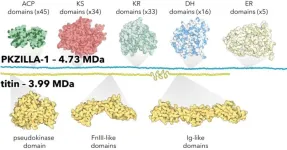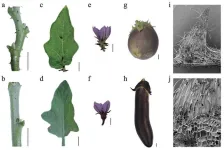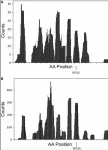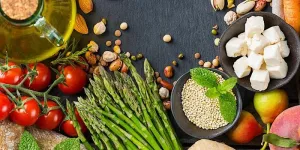(Press-News.org) While seeking to unravel how marine algae create their chemically complex toxins, scientists at UC San Diego’s Scripps Institution of Oceanography have discovered the largest protein yet identified in biology. Uncovering the biological machinery the algae evolved to make its intricate toxin also revealed previously unknown strategies for assembling chemicals, which could unlock the development of new medicines and materials.
Researchers found the protein, which they named PKZILLA-1, while studying how a type of algae called Prymnesium parvum makes its toxin, which is responsible for massive fish kills.
“This is the Mount Everest of proteins,” said Bradley Moore, a marine chemist with joint appointments at Scripps Oceanography and Skaggs School of Pharmacy and Pharmaceutical Sciences and senior author of a new study detailing the findings. “This expands our sense of what biology is capable of.”
PKZILLA-1 is 25% larger than titin, the previous record holder, which is found in human muscles and can reach 1 micron in length (0.0001 centimeter or 0.00004 inch).
Published today in Science and funded by the National Institutes of Health and the National Science Foundation, the study shows that this giant protein and another super-sized but not record-breaking protein – PKZILLA-2 – are key to producing prymnesin – the big, complex molecule that is the algae’s toxin. In addition to identifying the massive proteins behind prymnesin, the study also uncovered unusually large genes that provide Prymnesium parvum with the blueprint for making the proteins.
Finding the genes that undergird the production of the prymnesin toxin could improve monitoring efforts for harmful algal blooms from this species by facilitating water testing that looks for the genes rather than the toxins themselves.
“Monitoring for the genes instead of the toxin could allow us to catch blooms before they start instead of only being able to identify them once the toxins are circulating,” said Timothy Fallon, a postdoctoral researcher in Moore’s lab at Scripps and co-first author of the paper.
Discovering the PKZILLA-1 and PKZILLA-2 proteins also lays bare the alga’s elaborate cellular assembly line for building the toxins, which have unique and complex chemical structures. This improved understanding of how these toxins are made could prove useful for scientists trying to synthesize new compounds for medical or industrial applications.
“Understanding how nature has evolved its chemical wizardry gives us as scientific practitioners the ability to apply those insights to creating useful products, whether it’s a new anti-cancer drug or a new fabric,” said Moore.
Prymnesium parvum, commonly known as golden algae, is an aquatic single-celled organism found all over the world in both fresh and saltwater. Blooms of golden algae are associated with fish die offs due to its toxin prymnesin, which damages the gills of fish and other water breathing animals. In 2022, a golden algae bloom killed 500-1,000 tons of fish in the Oder River adjoining Poland and Germany. The microorganism can cause havoc in aquaculture systems in places ranging from Texas to Scandinavia.
Prymnesin belongs to a group of toxins called polyketide polyethers that includes brevetoxin B, a major red tide toxin that regularly impacts Florida, and ciguatoxin, which contaminates reef fish across the South Pacific and Caribbean. These toxins are among the largest and most intricate chemicals in all of biology, and researchers have struggled for decades to figure out exactly how microorganisms produce such large, complex molecules.
Beginning in 2019, Moore, Fallon and Vikram Shende, a postdoctoral researcher in Moore’s lab at Scripps and co-first author of the paper, began trying to figure out how golden algae make their toxin prymnesin on a biochemical and genetic level.
The study authors began by sequencing the golden alga’s genome and looking for the genes involved in producing prymnesin. Traditional methods of searching the genome didn’t yield results, so the team pivoted to alternate methods of genetic sleuthing that were more adept at finding super long genes.
“We were able to locate the genes, and it turned out that to make giant toxic molecules this alga uses giant genes,” said Shende.
With the PKZILLA-1 and PKZILLA-2 genes located, the team needed to investigate what the genes made to tie them to the production of the toxin. Fallon said the team was able to read the genes’ coding regions like sheet music and translate them into the sequence of amino acids that formed the protein.
When the researchers completed this assembly of the PKZILLA proteins they were astonished at their size. The PKZILLA-1 protein tallied a record-breaking mass of 4.7 megadaltons, while PKZILLA-2 was also extremely large at 3.2 megadaltons. Titin, the previous record-holder, can be up to 3.7 megadaltons – about 90-times larger than a typical protein.
After additional tests showed that golden algae actually produce these giant proteins in life, the team sought to find out if the proteins were involved in making the toxin prymnesin. The PKZILLA proteins are technically enzymes, meaning they kick off chemical reactions, and the team played out the lengthy sequence of 239 chemical reactions entailed by the two enzymes with pens and notepads.
“The end result matched perfectly with the structure of prymnesin,” said Shende.
Following the cascade of reactions that golden algae uses to make its toxin revealed previously unknown strategies for making chemicals in nature, said Moore. “The hope is that we can use this knowledge of how nature makes these complex chemicals to open up new chemical possibilities in the lab for the medicines and materials of tomorrow,” he added.
Finding the genes behind the prymnesin toxin could allow for more cost effective monitoring for golden algae blooms. Such monitoring could use tests to detect the PKZILLA genes in the environment akin to the PCR tests that became familiar during the COVID-19 pandemic. Improved monitoring could boost preparedness and allow for more detailed study of the conditions that make blooms more likely to occur.
Fallon said the PKZILLA genes the team discovered are the first genes ever causally linked to the production of any marine toxin in the polyether group that prymnesin is part of.
Next, the researchers hope to apply the non-standard screening techniques they used to find the PKZILLA genes to other species that produce polyether toxins. If they can find the genes behind other polyether toxins, such as ciguatoxin which may affect up to 500,000 people annually, it would open up the same genetic monitoring possibilities for a suite of other toxic algal blooms with significant global impacts.
In addition to Fallon, Moore and Shende from Scripps, David Gonzalez and Igor Wierzbikci of UC San Diego along with Amanda Pendleton, Nathan Watervoort, Robert Auber and Jennifer Wisecaver of Purdue University co-authored the study.
END
Largest protein yet discovered builds algal toxins
The findings could enhance monitoring efforts for harmful algal blooms, and unlock potential for new medicines or materials
2024-08-08
ELSE PRESS RELEASES FROM THIS DATE:
Researchers show nanovoids improve material performance
2024-08-08
Voids or pores have usually been viewed as fatal flaws that severely degrade a material's mechanical performance and should be eliminated in manufacturing.
However, a research team led by Prof. JIN Haijun from the Institute of Metal Research (IMR) of the Chinese Academy of Sciences has proposed that the presence of voids is not always hazardous. Instead, voids can be beneficial if they are added "properly" to the material.
The team demonstrated that a metal with a large number of nanoscale voids shows improved ...
Smooth sailing for eggplant: breakthrough in understanding prickle formation
2024-08-08
Scientists have discovered the gene responsible for prickles in eggplants, a trait that complicates farming. Using advanced genetic techniques, they identified the Prickly Eggplant (PE) gene on chromosome 6 and pinpointed SmLOG1 as the key factor. CRISPR-Cas9 gene editing confirmed that disabling SmLOG1 eliminates prickles, paving the way for prickle-free eggplant varieties. This breakthrough not only sheds light on prickle development but also promises to streamline eggplant cultivation and harvesting, benefiting the agricultural industry.
Eggplants, a staple crop globally, present significant challenges in cultivation and harvesting due to their prickles. These prickles, which serve as ...
Eating for necessity or pleasure? There is a brain circuit for that
2024-08-08
People eat either because they are hungry or for pleasure, even in the absence of hunger. While hunger-driven eating is fundamental for survival, pleasure-driven feeding may accelerate the onset of obesity and associated metabolic disorders. A study published in Nature Metabolism reveals neural circuits in the mouse brain that promote hunger-driven feeding and suppress pleasure-driven eating. The findings open new possibilities for developing strategies to combat obesity.
“Ideal feeding habits would balance eating for necessity and for pleasure, minimizing the latter,” said co-corresponding author Dr. Yong Xu, ...
TCR CDR3s and renalase-1 linked to increased melanoma survival
2024-08-08
“These findings indicate that renalase-1 is a potential antigen for TCR recognition in melanoma and could be considered as a target for immunotherapy.”
BUFFALO, NY- August 8, 2024 – A new research paper was published in Oncotarget's Volume 15 on August 5, 2024, entitled, “Chemical complementarity of tumor resident, T-cell receptor CDR3s and renalase-1 correlates with increased melanoma survival.”
As mentioned in the Abstract of this study, overexpression of the secretory protein renalase-1 negatively impacts the survival of melanoma and pancreatic cancer patients, while inhibition of renalase-1 signaling drives tumor ...
Department of Energy announces $4.6 million to fund public-private partnerships for fusion research
2024-08-08
Key Takeaways
-Fusion has the potential to provide abundant clean energy
-One to two-year awards range from $100,000 to $500,000
In a continuing effort to forge and fund public-private partnerships to accelerate fusion research, the U.S. Department of Energy (DOE) today awarded $4.6 million in 17 awards to U.S. businesses via the Innovation Network for Fusion Energy (INFUSE) program.
The goal of INFUSE is to accelerate fusion energy development in the private sector by reducing impediments to collaboration between business ...
Want to feel less stressed? Try the Mediterranean diet
2024-08-08
Following the Mediterranean diet versus the traditional Western diet might make you feel like you’re under less stress, according to new research conducted by a team from Binghamton University, State University of New York.
The findings suggest that people can lower their perception of how much stress they can tolerate by following a Mediterranean diet, said Lina Begdache, associate professor of health and wellness studies.
“Stress is recognized to be a precursor to mental distress, and research, including our own, has demonstrated that the Mediterranean diet lowers ...
Flow of sweetness: key sugar transporters identified for enhanced Camellia seed growth
2024-08-08
A recent study investigates the intricate mechanisms of sugar import in developing seeds of Camellia oleifera. By identifying key sugar transporters and analyzing their roles, the research provides significant insights into the molecular regulation of seed development. The findings highlight how these transporters, working alongside sucrose-metabolizing enzymes, facilitate efficient sugar import and partitioning. This study not only advances our understanding of seed development in Camellia oleifera but also suggests potential strategies to enhance seed yield and quality in this important ...
Not just an urban problem: new study reports higher rate of shootings by police across suburbs and rural areas
2024-08-08
Ann Arbor, August 8, 2024 – Media coverage of shootings by police typically involve urban incidents, giving the impression that the issue is unique to cities. However, national data built from the Gun Violence Archive tells a different story, showing a higher rate of shootings by police in rural and suburban areas than in cities during 2015-2020. A new study in the American Journal of Preventive Medicine, published by Elsevier, reports on the first nationwide, descriptive analysis of where, how often, and under ...
Drug shows promise for treating brain tumors resulting from breast cancer, UT Health San Antonio trial reports
2024-08-08
SAN ANTONIO, Aug. 8, 2024 – A drug effective in treating breast cancer shows new promise in addressing breast cancer with brain metastases or recurrent glioblastoma, as reported by results of a prospective window-of-opportunity trial at the University of Texas Health Science Center at San Antonio (UT Health San Antonio).
The window trial, in which patients agreed to receive a novel treatment before undergoing surgery, found that the drug Sacituzumab Govitecan was well-tolerated and showed signs of effectiveness for those whose breast cancer had progressed to brain tumors.
About half of all women with ...
Leading causes of death in the US, 2019-2023
2024-08-08
About The Article: This Viewpoint from the National Center for Health Statistics reports the leading causes of death in the U.S. from 2019 to 2023, including the emergence of COVID-19 and shifts in other top causes as pandemic deaths decreased.
Corresponding Author: To contact the corresponding author, Farida Bhuiya Ahmad, MPH, email hhi0@cdc.gov.
To access the embargoed study: Visit our For The Media website at this link https://media.jamanetwork.com/
(doi:10.1001/jama.2024.15563)
Editor’s Note: Please see the ...
LAST 30 PRESS RELEASES:
Eye for trouble: Automated counting for chromosome issues under the microscope
The vast majority of US rivers lack any protections from human activities, new research finds
Ultrasound-responsive in situ antigen "nanocatchers" open a new paradigm for personalized tumor immunotherapy
Environmental “superbugs” in our rivers and soils: new one health review warns of growing antimicrobial resistance crisis
Triple threat in greenhouse farming: how heavy metals, microplastics, and antibiotic resistance genes unite to challenge sustainable food production
Earthworms turn manure into a powerful tool against antibiotic resistance
AI turns water into an early warning network for hidden biological pollutants
Hidden hotspots on “green” plastics: biodegradable and conventional plastics shape very different antibiotic resistance risks in river microbiomes
Engineered biochar enzyme system clears toxic phenolic acids and restores pepper seed germination in continuous cropping soils
Retail therapy fail? Online shopping linked to stress, says study
How well-meaning allies can increase stress for marginalized people
Commercially viable biomanufacturing: designer yeast turns sugar into lucrative chemical 3-HP
Control valve discovered in gut’s plumbing system
George Mason University leads phase 2 clinical trial for pill to help maintain weight loss after GLP-1s
Hop to it: research from Shedd Aquarium tracks conch movement to set new conservation guidance
Weight loss drugs and bariatric surgery improve the body’s fat ‘balance:’ study
The Age of Fishes began with mass death
TB harnesses part of immune defense system to cause infection
Important new source of oxidation in the atmosphere found
A tug-of-war explains a decades-old question about how bacteria swim
Strengthened immune defense against cancer
Engineering the development of the pancreas
The Journal of Nuclear Medicine ahead-of-print tip sheet: Jan. 9, 2026
Mount Sinai researchers help create largest immune cell atlas of bone marrow in multiple myeloma patients
Why it is so hard to get started on an unpleasant task: Scientists identify a “motivation brake”
Body composition changes after bariatric surgery or treatment with GLP-1 receptor agonists
Targeted regulation of abortion providers laws and pregnancies conceived through fertility treatment
Press registration is now open for the 2026 ACMG Annual Clinical Genetics Meeting
Understanding sex-based differences and the role of bone morphogenetic protein signaling in Alzheimer’s disease
Breakthrough in thin-film electrolytes pushes solid oxide fuel cells forward
[Press-News.org] Largest protein yet discovered builds algal toxinsThe findings could enhance monitoring efforts for harmful algal blooms, and unlock potential for new medicines or materials






